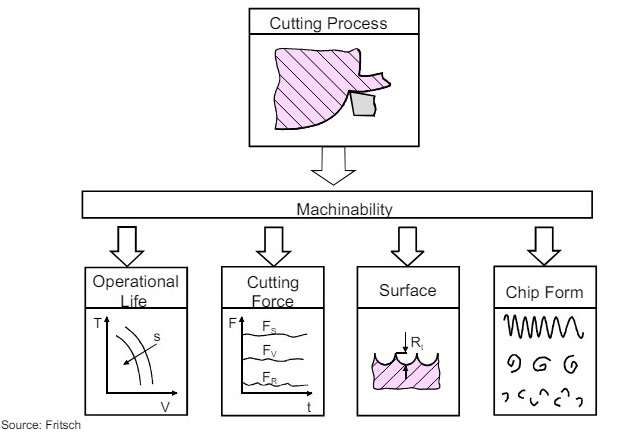Aluminium machinability
Understanding machinability of aluminium alloys, from low strength wrought alloys to heat hardened thermally non-hardened alloys. Machinabilty of Aluminium alloys includes AlMn, AlMg1, AlMg2, AlMg3, AlMg4, AlMg5, AlMgMn and AlMg4,5Mn.
Aluminium machinability: European classification
 Figure 1 – Definition of machinability [1]
Figure 1 – Definition of machinability [1]
The groups of aluminium machinability
From the point of view of machinability, aluminum alloys are divided into the following groups (in order of increasing difficulty of machining):
- Group 1: Low strength wrought aluminium alloys;
- Group 2.1: Deformable aluminium alloys of increased strength;
- Group 2.2: Aluminium alloys for machining;
- Group 3.1: Aluminium-silicon alloys with silicon content up to 10 %;
- Group 3.2: Eutectic aluminium-silicon alloys;
- Group 3.3: Hypereutectic aluminium-silicon alloys.
Group 1: Low-strength wrought aluminium alloys
1) Thermally non-hardenable alloys in annealed state or partially cold-worked state:
Examples of alloys:
- AlMn,
- AlMg1,
- AlMgMn.
2) Heat-hardening alloys in unaged state:
Examples of alloys:
- AlMgSi0,5,
- AlMgSi1.
Characteristic properties for machining:
- soft,
- plastic,
- low strength,
- no solids,
- tendency to stick to the cutting edge.
Group 2.1: High strength wrought alloys
1) Heat-hardened thermally unhardened alloys:
Examples of alloys:
- AlMn
- AlMg1, AlMg2, AlMg3, AlMg4, AlMg5
- AlMgMn
- AlMg4,5Mn
2) Heat treated alloys in aged and / or cold-worked condition:
Examples of alloys:
- AlCuMg1
- AlZnMg1
- AlZnMgCu0,5
- AlZnMgCu1,5
Characteristic properties for machining:
- strength from 300 to 600 N / mm2 with good elongation,
- no solids – low tool wear,
- decrease in strength with increasing tendency to stick to the cutting edge.
Group 2.2: Aluminium alloys for machining
Thermally treated wrought alloys with additives for chipbreaking
Examples of alloys:
- AlMgSiPb
- AlCuBiPb
- AlCuMgPb
Characteristic properties for machining:
- short chips due to the presence of Pb and Bi additives;
- strength from 280 to 380 H / mm2;
- low tendency to stick on the cutting edge.
Group 3.1: Al-Si cast alloys with silicon content up to 10 %
1) AlSiCu alloys
Examples of alloys:
- AlSi5Cu1
- AlSi6Cu4
- AlSi8Cu3
2) AlSiMg alloys
Examples of alloys:
- AlSi7Mg
- AlSi9Mg
- AlSi10Mg
Characteristic properties for machining:
- strength from 250 to 360 N / mm2;
- increased wear of the cutting tool due to hard components of the microstructure and inclusions;
- good chip brittleness and smooth surface;
- the tendency to stick to the cutting edge with the content aremniya more 5 %.
Group 3.2: Low hardness Al-Si cast alloys
Al-Si alloys with a silicon content of about 12 %
Alloy example:
- AlSi12
Characteristic properties for machining:
- low hardness of the aluminium matrix;
- solid metal microstructure components and inclusions;
- high propensity to stick on the cutting edge.
Group 3.3: High hardness Al-Si cast alloys
Al-Si alloys with silicon contents exceeding 12 %
Examples of alloys:
- AlSi18CuMgNi
- AlSi21CuNiMg
- AlSi25CuMgNi
- AlSi17Cu4FeMg
Characteristic properties for machining:
- medium strength;
- high hardness;
- very low plasticity;
- high wear of the cutting tool due to very hard intermetallic particles and primary silicon;
- high propensity to stick on the cutting edge.
Sources:
- Machining of Products – TALAT Lecture 3100 /P. Johne, Aluminium-Zentrale e.V., Düsseldorf – 1994
- Aluminum and Aluminum Allooys – ASM Speciality Handbook – Ed. J.R. Davis – 1993
